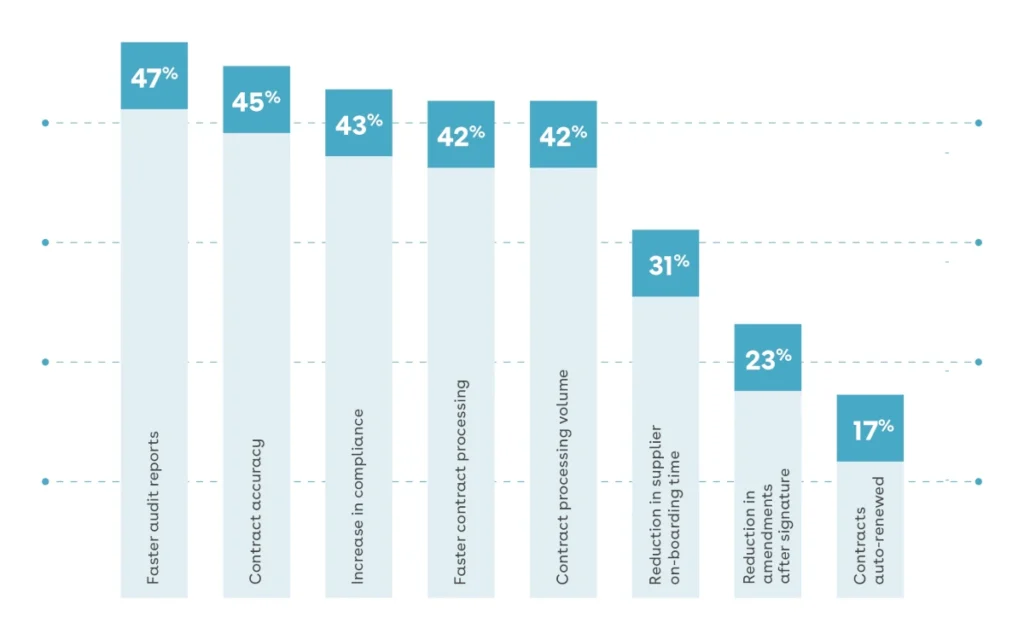Sell-side & Buy-side Contracts
Not every contract is a sales contract, so a contract management system should be able to support any type of contract. While contracts that your sales team is responsible for are critical, buy-side contracts can introduce value to the organization – they have their own unique set of needs and processes.
Buy-side contracts are key in procurement and finance efforts to closely monitor every dollar your company is spending. With contract lifecycle management at the center of their buying process, these teams can reach agreements with suppliers faster, negotiate more effectively, and track supplier compliance more accurately.
It’s important to evaluate solutions that can support both your buy-side and sell-side contracts to avoid siloed processes and duplicate tools. For many businesses, the buying process and the selling process are inherently related, so it’s imperative that your contract management solution encompass all contract types to promote visibility across all agreements. Otherwise you’re just getting part of the picture—and what you can’t see can hurt you.
General contracts
Lastly, many other business teams require contracts to manage employment, intellectual property, real estate, and other needs. Such “general” contracts are of interest to HR, operations, IT, R&D, and—of course—legal departments. A contract lifecycle management solution allows individual teams to request, author, negotiate, execute, comply, and renew with ease, especially with self-service functionality.
Easing common contract management pain points
If contracts are completed faster, you can collect on them sooner. If they’re accurate, you have fewer revisions to slow down the process and likely fewer disputes later on. General counsel and C-level executives will be reassured because they’ll have confidence that the contract management process is working.
The benefits of automating contract management are real. But so are the pains. Here is a look at the five most common pain points of inefficient contract lifecycle management and some of the ways to overcome them.
5 common contract pain points
Speed vs. control
The biggest source of friction in the contract lifecycle comes from the balancing act between speed and control. Because contracts are so critical, legal prefers to examine contracts with a fine-tooth comb. Sales often has a different perspective, pressuring legal to get out of the way so deals can close faster. The main business challenge becomes moving contracts through quickly, but with enough oversight to effectively manage risk.
Lack of visibility
Part of what exacerbates the speed vs. control dilemma for legal is a general lack of visibility into contract terms, obligations, and value. If you can’t see it, you can’t control it. This becomes a major pain point because agreements outline the terms of the value exchanged, and if you can’t ensure the right value for deals, money is slipping through your company’s fingers. Lack of visibility is an especially serious problem for expiring contracts and renewals.
Inconsistent legal language
It’s important to be consistent in the use of terms and language in your contracts. Gaps in standardized language can introduce risk or confusion. If you can’t determine whether contracts contain accurate language or identify the difference between contracts, lawyers might have to get involved in every single deal. This also increases the risk of being non-compliant or leaving revenue on the table.
Information silos and manual processes
Managing all the necessary steps in the contract process is hard enough across several internal departments. The complexity of managing contracts increases exponentially when you manage contracts across multiple office locations, time zones, or languages. The ability to have everything centrally located with changes tracked in real-time is critical. When contracts are managed manually, human error, bottlenecks in the contract cycle, and limited control of processes can lead to dramatic increases in risk. Automating contract management helps companies improve control and visibility and significantly shortens contract creation time.
Inability to manage change
The customer relationship gets more valuable once the deal is signed, so it’s important to have a mechanism for managing changes over time. You need to be up to speed on renewal dates, pricing changes, emerging legal requirements, and other events that require you to speak to the customer specifically about the
contractual relationship. If you drop the ball on contract-related communications, you risk compromising the relationship with the customer—especially if the contract language (or lack thereof) exposes the customer to new risk. Your ability to manage the contract, particularly through changes over time and the renewal process, will have a direct impact on the quality of the customer relationship and on your customer retention rate, as a result.
Ineffective contract management can cost most businesses up to 10% of revenue
Effective contract lifecycle management accelerates deals and reduces risk. Average percentage improvements reported…

Source: Conga Quote-to-Cash (QTC) Impact Study conducted June 2017 by an independent third-party, Satmetrix on 200+ Conga customer contacts randomly selected. Performance metrics are intended as a guideline based upon historical results from a sample set of customers. Results are dependent upon many different factors that are customer-specific. Therefore, actual results will vary. Response size per question varies. In May 2020, Apttus and Conga joined forces as the all-new Conga, bringing together their solutions and customer bases.